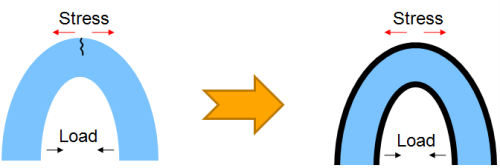

Home of Toughened Fibers
Modern-day applications for optical fiber require mechanical properties well beyond the requirements for conventional optical fiber, whose main application is in long distance telecommunication and where optical performance alone has always been the main priority. As datacom applications have proliferated in recent years, optical cables designed for the protection of fragile optical fibers must now abandon the safety of underground deployment, and face exposure to a potentially much harsher operating environment, and face exposure to a potentially much harsher operating environment. In many situations optical cables are now exposed to human contact nearly to the extent that are copper cables. Under such circumstances, toughened optical fibers are an indispensible requirement.
Fiber Toughening Mechanism
Since the beginning of optical fiber adoption in telecommunication in the late 1970s, improving the optical performance of the fiber has been the main thrust of research and development. This is obvious and arises from the need to transmit signals over long distances in such applications. Mechanical performance, on the other hand, is less critical in such optical cable as optical fibers are protected in heavy polymer jackets and are typically deployed underground (or undersea). However, the design criteria for optical fiber required in data communications and other applications is not the same.


Today, the application set for optical fiber has widened from telecom to datacom to consumer electronics, and end customers are shifting gradually from telecom installation professionals to general consumers. As a result of this shift, the mechanical strength of the optical fiber has become a critical concern, and ironically, the optical performance of the typical optical fiber is somewhat over-designed for such applications, which require relatively short-distance signal transmission.
Conventional optical fibers are typically fragile in nature due largely to surface damage formed during the fiber drawing process. Such surface flaws will develop into cracks under stress, and final failure in broken fibers typically results from crack propagation caused by contact with moisture or under stress. Conceptually, the fiber toughening mechanism can be as simple as employing a protective coating on the optical fiber surface directly.

